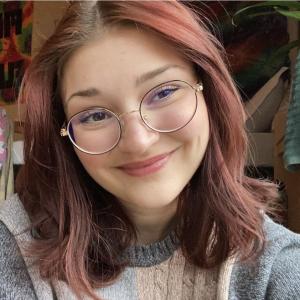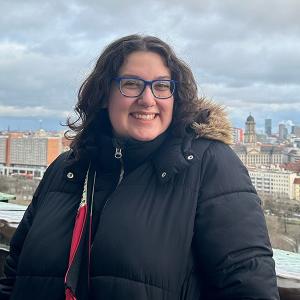Oberlin Blogs
Dancing My Way Through Winter Term
January 29, 2024
Ida Rosenstein ’26
One thing to know about me is that while I am not particularly very good at dancing, I love to do it. I've been a member of the Oberlin Swing & Blues Club since freshman year and have steadily improved my abilities. I still have plenty to learn, but I am much more confident in my dancing abilities than I used to be. Because I enjoy it so much, I usually find time to make it happen, whether at the 'Sco, an open dance workshop, a swing dance or just bouncing around my dorm. So, with many clubs and events on pause over the Winter Term, I knew that I needed to be diligent in my efforts to find dancing opportunities.
Blues Dancing:
Winter is a hard time for me in terms of physical activity. When it's bitterly cold outside, there's nothing more I want to do than cuddle up in my bed all day, which inevitably creates a pattern of idleness. When I can stay cozy and warm in my room all day, motivating myself to get up is difficult. Luckily for me, the wonderful OSwing & Blues Club members managed to coordinate several outings to various dances in the Cleveland area!
My roommate and I attended a blues dance with the OSwing Club at The Brownhoist, a beautiful historic building refashioned into an event space! The dance was hosted by Burning River Blues, a local blues dancing organization. The event began with a lesson at 7:00, where we all learned the basics of blues dancing, a simple style of partner dancing that allows for lots of improvisation. I had a great time practicing with my friends, but the prospect of dancing with the other guests in attendance was initially intimidating. I could tell from watching that many of them were experienced dancers, and I was only a beginner. However, I was pleasantly surprised that so many of them approached me for a dance—up until now, I had only done partner dancing with people I knew. It was a new but certainly enjoyable experience for me.
The environment was incredibly welcoming: everybody was eager to chat with and learn from each other. Quickly, any worries I felt about impeding others quickly dissipated. One of my experienced partners taught me an interesting improvisational technique: to form a dance based on the first thing the music brings to mind. Naturally, much of the country music inspired me to channel my inner cowgirl. As a follow, I was comfortable adjusting to whatever the lead decided to do next. But there were also many chances for me to improvise on my own, apart from the lead. Many of my partners would break the hand-to-hand connection at certain points to allow for freer movement, so I had plenty of time to stylize myself as well.
Soundpainting:
Along with blues, I experienced quite a few forms of dance over the Winter Term with my lovely roommate, Natalie. Natalie participated as a dancer in a soundpainting class for her Winter Term project. What is soundpainting? you might ask. Well, as described by Walter Thompson (its creator and the instructor of the WT class), soundpainting is a "multidisciplinary and interdisciplinary improvisational, compositional, sign language." Take a breath. That's a lot of words to remember. In essence, soundpainting involves a "soundpainter," who composes the piece through hand signs, and various performers: the musicians, dancers, actors, singers, and visual artists who interpret the soundpainter's gestures. There are more than 1500 gestures that the soundpainter may use to direct the performers. Examples include gestures for a long tone, increasing/decreasing volume, minimalism, and many more.
When Natalie recounted her soundpainting classes, I was intrigued about what it felt like to participate in. She talked about it with such enthusiasm, said that it felt like a reprieve from the focus on precision-perfect technique in other forms of dancing. I had done improv before, but that was in theatre and involved much less guidance. So, when I learned from Natalie that there would be an open workshop, I knew I had to try it.
The workshop began with a brief introduction from Walter about the history and purpose of soundpainting. The participants primarily consisted of musicians and dancers, which I chose as my discipline. Walter explained a few basic signs and slowly introduced more as we practiced. My personal favorite was a gesture called "pointillism." It consisted of the soundpainter rapidly pointing above themselves, prompting the performers to make quick, jerky movements or sounds. It was full of energy and allowed lots of variation in movement. I enjoyed how Walter emphasized that there was no "wrong" way to interpret his gestures. He reassured us that the soundpainter never expects anything specific from the performers; it is a collaborative effort more than anything else. This aspect was incredibly freeing; I didn't feel restrained by trying to predict what the composer wanted. It reminded me of the kind of activities you go to a liberal arts college for: the unconventional and experimental—something that focuses intensely on personal expression.
Overall, soundpainting was a fantastic experience for me! All the performers played off one another very well, letting their movements and sounds continue to build from the previous ones. I'm not a particularly gifted dancer, but that didn't matter here. I was meant to see where the music and soundpainter's direction would take me. I let myself get lost in everything and did not think too hard about what I would do next. The great thing about soundpainting is that it is open to everyone: all skill, knowledge, and ability levels. It is a completely judgment-free zone that truly allows you to experiment to your heart's content.
Bulgarian Dance:
Finally, I also attended a student-led Bulgarian dance lesson during the Winter Term. I gathered a small group of friends and dragged them with me to the class! Though I only had the chance to attend one of the six classes, it was a joy to learn.
We first learned the "Horo" dance, a traditional folk dance performed in a large group. The steps were simple enough for me to remember, so I (foolishly) thought that I was getting the hang of it. This was slightly complicated, though, because Bulgarian folk music has an asymmetrical meter, so I struggled to adjust to the rhythm when we practiced. But the music and crowd were so high energy that I found myself able to bounce along easily enough.
Next, we learned the "Pravo Horo," which seemed relatively straightforward. When we practiced, I demonstrated my mastery of the form by constantly forgetting which foot was my right and which was my left. I also regularly tripped over my own feet: this was not part of the dance, if you can believe it. Additionally, I became an absolute mess when we began to switch from "Horo" to "Pravo Horo" at random points throughout the dance. However, this did not stop me at all from having a blast dancing with everyone! Despite my atrocious technique and memory, there was so much joy in dancing and fumbling with the rest of the group. If I stumbled, I stumbled along with someone else.
Similar Blog Entries


Omar at Oberlin
December 15, 2024
A starstruck, once-in-a-lifetime opportunity awaited me this semester!
